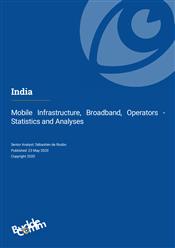India - Mobile Infrastructure, Broadband, Operators - Statistics and Analyses

Last updated: 23 May 2020 Update History
Report Status: Archived
Report Pages: 73
Analyst: Sebastien De Rosbo
Synopsis
India’s mobile market dominates the local telecom sector, having a large subscriber base and revenue as well as huge capital investment by operators. It remains a highly competitive market though the number of players has fallen in recent years as a result of bankruptcies and merger activity. Four operators alone account for 9.6% of all subscribers.
The emergence of Reliance Jio in the market in 2016 was disruptive. The operator’s strategy was to provide free voice and data initially in a bid to win customers, and then encourage churn from competitors through cut-priced packages. This resulted in a sharp fall in ARPU for most operators, and a sharp loss of subscribers by some, including RCOM which saw its subscriber base nearly wiped out.
Slower market growth is predicted over the next few years, with growth in 2020 partly affected by the disruption caused by the COVID-19 pandemic. The market will also be constrained from higher growth as a result of local competition and the relatively high penetration.
Mobile broadband penetration has developed strongly over the past few years, driven by the greater number of mobile subscribers, the wider availability and LTE infrastructure and the greater adoption of data-based services.
Uptake of next generation technologies such as IoT, and evolving trends such as smart cities, and new devices offering virtual reality experiences will all enhance data usage going forward. Operators will increasingly focus on infrastructure investments such as optical fibre and small cells for expanding LTE coverage and capacity.
India has taken initial steps towards the rollout of 5G services and is developing a 5G corridor in New Delhi as part of technology trials. However, the government has postponed the auction of 5G suitable spectrum until 2021, and given the financial difficulties faced by operators having to pay high tax dues there will be little incentive to prioritise 5G until 2021 or 2022.
Key developments:
- Government delays multi-spectrum auction to late 2020 but delays 5G spectrum auction to 2021;
- BSNL partners with Ciena to conduct field trials of 5G technology;
- Bharti Airtel makes final AGR payment;
- Vodafone Idea facing financial ruin caused by tax dues;
- Report update includes the regulator’s market data to January 2020, operator data to Q1 2020, recent market developments.
Companies covered in this report include:
Aircel, Bharti Airtel, Quadrant (HFCL), Vodafone Idea, Reliance Communications, Reliance Jio Infocomm (RJI), Tata Teleservices, Vodafone Essar, Videocon, Sistema, Videsh Sanchar Nigam (VSNL), Bharat Sanchar Nigam (BSNL), Mahanagar Telephone Nigam (MTNL), Videocon
Related Reports
- India - Telecoms, Mobile and Broadband - Statistics and Analyses
- 2019 Asia - Mobile Network Operators and MVNOs
- 2019 Asia - Fixed Broadband Market - Statistics and Analyses
- 2019 Asia - Mobile Infrastructure and Mobile Broadband
- Cambodia - Telecoms, Mobile and Broadband - Statistics and Analyses
- Philippines - Telecoms, Mobile and Broadband - Statistics and Analyses
- Laos - Telecoms, Mobile and Broadband - Statistics and Analyses
- Singapore - Telecoms, Mobile and Broadband - Statistics and Analyses
- Armenia - Telecoms, Mobile and Broadband - Statistics and Analyses
- Timor Leste (East Timor) - Telecoms, Mobile and Broadband - Statistics and Analyses
Share this Report
TMT Intelligence
A platform to scale your intelligence tasks
Monitor critical insights with our AI-powered Market Intelligence Platform gathering and analyzing intelligence in real time. With AI trained to spot emerging trends and detect new strategic opportunities, our clients use TMT Intelligence to accelerate their growth.
If you want to know more about it, please see:
Research Methodology
BuddeComm's strategic business reports contain a combination of both primary and secondary research statistics, analyses written by our senior analysts supported by a network of experts, industry contacts and researchers from around the world as well as our own scenario forecasts.
For more details, please see:
More than 4,000 customers from 140 countries utilise BuddeComm Research
Are you interested in BuddeComm's Custom Research Service?
Hot Topics
News & Views
Have the latest telecommunications industry news delivered to your inbox by subscribing to BuddeComm's weekly newsletter.